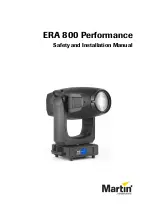
• Also remove the rack from the dispenser prior to cleaning, disinfecting and sterilising the individual components.
• Manual cleaning alone is not sufficient to recondition the dispenser correctly. Cleaning must always be followed
by disinfection and sterilisation.
• Manual disinfection alone is not sufficient to recondition the dispenser correctly. Disinfection must always be
followed by sterilisation.
• Manually clean and disinfect the dispenser within 1 hour of use.
• Manual disinfection of the dispenser must always be performed using a solution of isopropyl alcohol (<20%)
and quaternary ammonium salts (<0.3%) (e.g. CaviWipes®). Follow the chosen disinfectant manufacturer’s
instructions for contact time.
• The use of disinfectant solutions containing phenolic, iodophoric or organic solutions (e.g. alcohol) may cause
stains to appear on the surfaces of the device over time.
• Intermediate level disinfection (inactive against spores) has been validated for dispenser disinfection purposes.
• The dispenser
MUST NOT BE
:
- sterilised with chemical vapour, dry heat or with cold chemical immersion sterilisers;
- immersed in disinfectant liquids, as these could cause discolouring or deterioration;
- cleaned/disinfected in instrument washing machines or thermal disinfection devices;
- cleaned in ultrasonic baths.
• No automatic methods of disinfection have been validated for the dispenser.
• The dispenser must always be cleaned, disinfected and sterilised before being put away in a place suitable for its storage.
• The dispenser must always be sterilised before use.
• Sterilisation temperature for the dispenser and rack must not exceed 132°C.
• Steam sterilisation in an autoclave has been validated as a method for sterilising the dispenser.
• Once sterilised, the dispenser and rack must be stored in their sterilisation packaging in a closed, clean and dry
place well away from splashes, sprays or aerosols of bodily fluids.
• Inspect the sterilisation packaging before reusing the dispenser. If the packaging appears damaged or damp,
recondition the dispenser and rack again before use.
6.2.1 DISASSEMBLING THE DEVICE:
a. BEFORE FIRST USE
1. Use a Phillips screwdriver to remove the screws from the two disks securing the rack (fig. 1.1).
2. Remove both disks then press the black lever (fig. 1.2/1) and pull out the rack in the direction shown by the arrow
(fig. 1.2/2).
3. Replace the disks on the rack using the screws removed previously (fig. 1.3).
4. The dispenser is now disassembled (fig. 1.4) and ready for cleaning, disinfection and sterilisation (see sections 6.2.2,
6.2.3 and 6.2.4).
b. AFTER EVERY USE
1. Place the contaminated dispenser in a clean, closed container and take it to the area designated for cleaning and
disinfection.
2. Remove the disposable cover / barrier envelope.
3. Remove your contaminated gloves, disinfect your hands and put on a pair of clean gloves.
4. Press the black lever on the dispenser (fig. 2.1/1) and pull the rack back to the start of its stroke (fig. 2.1/2).
5. Lift up the cartridge lock (fig. 2.2/1). Remove the cartridge from the dispenser (fig. 2.2/2), then clean and disinfect it
following the instructions provided by the cartridge manufacturer.
6. Use a Phillips screwdriver to remove the screws from the two disks securing the rack (fig. 2.3).
7. Remove both disks then press the black lever (fig. 2.4/1) and pull out the rack in the direction shown by the arrow
(fig. 2.4/2).
8. Replace the disks on the rack using the screws removed previously (fig. 2.5).
9. The dispenser is now disassembled (fig. 2.6) and ready for cleaning, disinfection and sterilisation (see sections 6.2.2,
6.2.3 and 6.2.4).










































